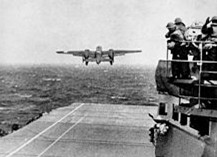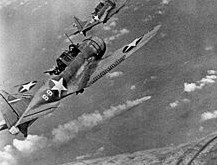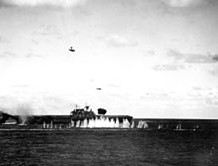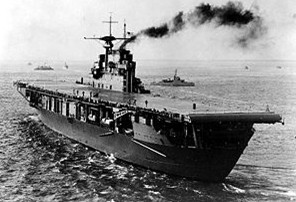
USS Hornet CV-8
Wikipedia | 2013-11-29 11:49
USS Hornet CV-8, the seventh ship to carry the name Hornet, was a Yorktown-class aircraft carrier of the United States Navy. During World War II in the Pacific Theater, she launched the Doolittle Raid on Tokyo and participated in the Battle of Midway and the Buin-Faisi-Tonolai Raid. In the Solomon Islands campaign she was involved in the Capture and Defense of Guadalcanal and the Battle of the Santa Cruz Islands where she was irreparably damaged and sunk. Hornet was in service for a year and six days and was the last US fleet carrier ever sunk by enemy fire. For these actions, she was awarded four service stars, a citation for the Doolittle Raid in 1995, and her Torpedo Squadron 8 received a Presidential Unit Citation for extraordinary heroism for the Battle of Midway.
World War II
She was launched on 14 December 1940 by Newport News Shipbuilding of Newport News, Virginia[3](sponsored by Annie Reid Knox,[4] wife of Secretary of the Navy Frank M. Knox), and commissioned at Norfolk on 20 October 1941, with Captain Marc A. Mitscher in command.
During the uneasy period before the attack on Pearl Harbor, Hornet trained out of Naval Station Norfolk. Her armament was upgraded in her January 1942 yard period, removing all .50 in (13 mm) machine guns and replacing them with thirty 20 mm Oerlikon anti-aircraft cannons. A hint of a future mission occurred on 2 February 1942, when Hornet departed Norfolk with two Army Air Forces B-25 Mitchell medium bombers on deck. Once at sea, the planes were launched to the surprise and amazement[6] of Hornet's crew. Her men were unaware of the meaning of this experiment, as Hornet returned to Norfolk, prepared to leave for combat, and on 4 March sailed for the West Coast via the Panama Canal.
Doolittle Raid, April 1942
Hornet arrived at Naval Air Station Alameda, California on 20 March 1942.[8] With her own planes on the hangar deck, by midafternoon on 1 April she loaded 16 B-25s on the flight deck.[9] Under the command of Lieutenant Colonel James H. Doolittle, 70 United States Army Air Corps officers and 64 enlisted men reported aboard. In company of her escort, Hornet departed Alameda on 2 April[9] under sealed orders. That afternoon, Captain Marc Mitscher informed his men of their mission: a bombing raid on Japan.
Eleven days later, Hornet joined the aircraft carrier Enterprise off Midway, and Task Force 16 (TF 16)[10] turned toward Japan. With Enterprise providing combat air cover, Hornet was to steam deep into enemy waters. Originally, the task force intended to proceed to within 400 nmi (460 mi; 740 km) of the Japanese coast; however, on the morning of 18 April, a Japanese patrol boat, No. 23 Nitto Maru, sighted the American task force. Nashville sank the patrol boat.[11] Amid concerns that the Japanese had been made aware of their presence, Doolittle and his raiders were forced to launch prematurely from 600 nmi (690 mi; 1,100 km) out instead of the planned 450 nmi (520 mi; 830 km). Because of this decision, none of the 16 planes made it to their designated landing strip in China. After the war, it was found that Tokyo received the Nitto Maru's message in a garbled form and that the Japanese ship was sunk before it could get a clear message through to the Japanese mainland.
As Hornet swung about and prepared to launch the bombers, which had been readied for take-off the previous day, a gale of more than 40 kn (46 mph; 74 km/h) churned the sea with 30 ft (9.1 m) crests; heavy swells, which caused the ship to pitch violently, shipped sea and spray over the bow, wet the flight deck and drenched the deck crews. The lead plane, commanded by Colonel Doolittle, had only 467 ft (142 m) of flight deck, while the last B-25 hung its twin rudders far out over the fantail. Doolittle, timing himself against the rise and fall of the ship's bow, lumbered down the flight deck, circled Hornet after take-off, and set course for Japan. By 09:20, all 16 were airborne, heading for the first American air strike against the Japanese home islands.

A B-25 takes off from Hornet.
Hornet brought her own planes on deck as TF 16 steamed at full speed for Pearl Harbor. Intercepted broadcasts, both in Japanese and English, confirmed at 14:46 the success of the raids. Exactly one week to the hour after launching the B-25s, Hornet sailed into Pearl Harbor. Hornet's mission was kept an official secret for a year; until then President Roosevelt referred to the base the bombers started from only as "Shangri-La". Several years later, the USN would give this name to an aircraft carrier.
Hornet steamed from Pearl Harbor on 30 April to aid Yorktown and Lexington[14] at the Battle of the Coral Sea, but the battle ended before she reached the scene. On 4 May Task Force 16 crossed the equator, the first time ever for Hornet.[15] After executing, with Enterprise, a feint towards Nauru and Banaba (Ocean) islands which caused the Japanese to cancel their operation to seize the two islands, she returned to Hawaii on 26 May, and sailed two days later to help repulse an expected Japanese assault on Midway.
Battle of Midway, June 1942

SBDs from Hornet at Midway
On 28 May, Hornet and Task Force 16 steamed out of Pearl Harbor heading for Point "Luck", an arbitrary spot in the ocean roughly 325 miles northeast of Midway, where they would be in a flank position to ambush Japan's mobile strike force of four frontline aircraft carriers the Kido Butai. Japanese carrier-based planes were reported headed for Midway in the early morning of 4 June 1942. Hornet, Yorktown, and Enterprise launched aircraft,[19] just as the Japanese carriers struck their planes below to prepare for a second attack on Midway. Hornet dive bombers followed an incorrect heading and did not find the enemy fleet. Several bombers and all of the escorting fighters were forced to ditch when they ran out of fuel attempting to return to the ship.[20] Fifteen torpedo bombers of Torpedo Squadron 8 (VT-8) found their enemy and pressed home their attacks. They were met by overwhelming fighter opposition about 8 nmi (9.2 mi; 15 km) out, and with no escorts to protect them, they were shot down one by one. Ensign George H. Gay, USNR, was the only survivor of 30 men.
Further attacks by Enterprise and Yorktown torpedo planes proved equally disastrous, but succeeded in forcing the Japanese carriers to keep their decks clear for CAP operations, rather than spotting a counter-attack against the Americans. Japanese fighters were finishing off the last of the torpedo planes over Hiryū when dive bombers of Enterprise and Yorktown attacked, starting enormous fires aboard the three other Japanese carriers that led to their loss. Hiryu was hit late in the afternoon of 4 June by a strike from Enterprise and sank early the next morning. Hornet aircraft, launching late due to the necessity of recovering Yorktown scout planes and faulty communications, attacked a battleship and other escorts, but failed to score hits. Yorktown was lost to combined aerial and submarine attack.
The Hornet's warplanes attacked the fleeing Japanese fleet on 6 June 1942, and they assisted in sinking the heavy cruiser Mikuma, damaging a destroyer, and leaving the heavy cruiser Mogami, heavily damaged and on fire, to limp away from the battle zone. The attack by the Hornet's on the Mogami ended one of the great decisive battles of naval history. Midway Atoll was saved as an important base for American operations into the Western Pacific Ocean. Of greatest importance was the crippling of the Japanese carrier strength, a severe blow from which the Imperial Japanese Navy never fully recovered. The four large carriers took with them to the bottom about 250 naval aircraft and a high percentage of the most highly trained and experienced Japanese aircraft maintenance personnel. The victory at Midway was a decisive turning point in the War in the Pacific. See History of United States Naval Operations in World War II, Volume 4.
Solomons campaign, August–October, 1942
Following the battle of Midway, Hornet had a new CXAM radar installed atop her tripod mast, and her SC radar was relocated to her mainmast, an additional 1.1 in (28 mm) quad mount was added at her bow, her armament of 20 mm antiaircraft guns was increased from 30 to 32 mounts, and her athwartships hangar-deck aircraft catapult was removed.
Hornet steamed out of harbor on 17 August to guard the sea approaches to bitterly-contested Guadalcanal in the Solomon Islands. Bomb damage to Enterprise (24 August), torpedo damage to Saratoga (31 August), and the sinking of Wasp on 15 September left Hornet as the operational U.S. carrier in the South Pacific. She bore the brunt of providing air cover over the Solomon Islands until 24 October, when she was joined by Enterprise just northwest of the New Hebrides Islands. These two carriers and their escorts then steamed out to intercept a Japanese aircraft carrier/battleship/cruiser force closing in on Guadalcanal.

Hornet under attack during the Battle of the Santa Cruz Islands
The Battle of the Santa Cruz Islands took place on 26 October without contact between surface ships of the opposing forces. That morning, Enterprise's planes bombed the carrier Zuihō, while planes from Hornet severely damaged the carrier Shōkaku and the heavy cruiser Chikuma. Two other cruisers were also attacked by Hornet's warplanes. Meanwhile, Hornet was attacked by a coordinated dive bomber and torpedo plane attack. In a 15-minute period, Hornet took three bomb hits from Aichi D3A "Val" dive bombers, another bomb hit compounded by the "Vals" crashing itself onto her flight deck, two torpedo hits from Nakajima B5N "Kates", and another "Val" crashing onto her deck.
Rear Admiral George D. Murray ordered the heavy cruiser Northampton to tow Hornet clear of the action. Since the Japanese planes were attacking Enterprise, this allowed Northampton to tow Hornet at a speed of about five knots. While under tow, she came under attack again from another wave of torpedo bombers later in the day. A "Kate" scored another torpedo hit, and the order of "abandon ship" was issued. Captain (U.S. Navy) Charles P. Mason, the last man on board, climbed over the side, and the survivors were soon picked up by the escorting destroyers.
American warships next attempted to scuttle the stricken carrier, which absorbed nine torpedoes, many of which failed to explode, and more than 400 5-inch naval artillery rounds from the destroyers Mustin and Anderson. The destroyers steamed away when a Japanese surface force entered the area. The Japanese destroyers Makigumo and Akigumo finally finished off Hornet with four 24-inch Long Lance torpedoes. At 01:35 on 27 October, Hornet was finally sunk with the loss of 140 of her sailors. She was struck from the Naval Vessel Register on January 13, 1943, but her name was reused that same year for a new Essex class aircraft carrier. Other than light carriers and escort carriers, Hornet was the last U.S. fleet carrier ever sunk by enemy fire
Share this page




















